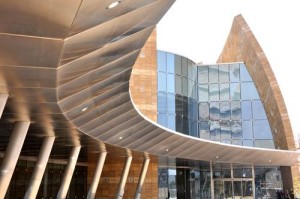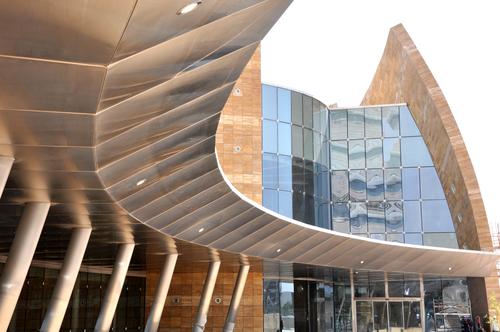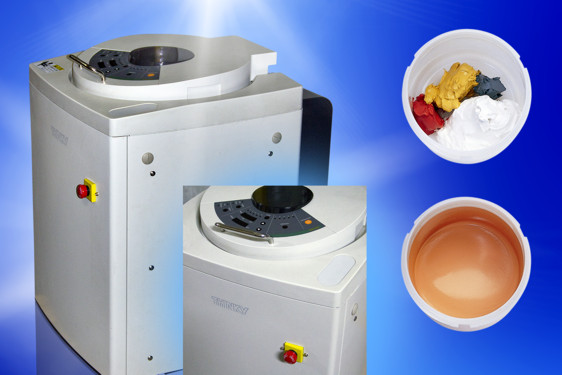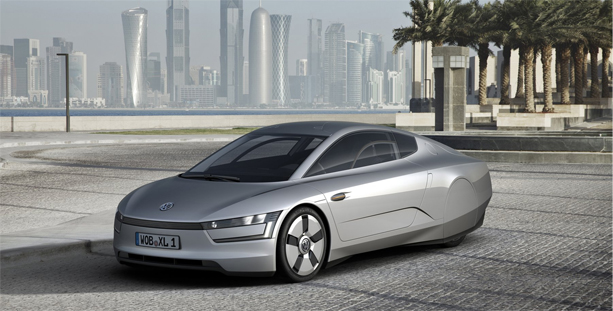
Along with Shanghai and Hong Kong, Dubai is one of the world’s cities where some highly unusual buildings are being designed and built. Many of these have curved shapes that are difficult or impossible to realize in heavy building materials like concrete, steel, and glass. Composites, which engineers are using to build spacecraft, seawalls, and car wheels, are now helping architects to make curved and freeform shapes in large buildings in the Middle East.
Affan Innovative Structures, based in Dubai in the United Arab Emirates (UAE), has combined a carbon fiber with Dow Chemical’s Voraforce TF epoxy infusion systems. The company is using the composite material to build non-load-bearing structures in projects such as the Yas Mall in Abu Dhabi, UAE, and the Sidra Hospital in Qatar, which are both under construction.
Amer Affan, the company’s founder and managing partner, told us the curved architectural panels created using Dow toughened epoxy technology have many advantages compared to steel, the conventional material. The composite reduces weight by 85 percent and is 1.9 to 2 times the strength of steel, although its flexibility and toughness are lower than steel.
Strength and a light weight, along with the material’s energy absorbance, are also important in the earthquake-prone Middle East to help reduce damage. This was especially advantageous for the design of the canopy foundations in the Sidra Hospital. The composite material was used in the pillars and roofing of the hospital’s entrance area. The roofing panels made of the composite measure 15m to 25m (49 ft to 82 ft) long. None of these structures are load-bearing.
Affan told us:
Composites are important to allow architects freeform shapes in buildings. Using metal it would take a lot of effort both in time and money to achieve these architectural forms. The same characteristics of composites that have benefited automobiles, aircraft, and sports equipment are also proving beneficial to architects. In many ways, composites can be a dream solution for architects and I am convinced that they will decisively influence the future of construction.
Dow’s Voraforce TF epoxy systems were specifically developed for the infusion process. The systems have very low viscosity and low exothermicity, resulting in optimal fiber wetting and efficient processing. Low starting viscosity allows fast infusion, leading to short cycle times, and good fiber impregnation, while low exothermicity guarantees the composite’s high final quality. For example, the infusion time for a part 25m x 3m (49 ft x 9.8 ft) made of the composite material was less than 20 minutes. “The total wetting of the fibers was clearly visible even in this relatively short time for such a large area of infusion,” said Affan. “This is very efficient processing.”
Affan Innovative Structures provides design, engineering, fabrication, and installation, focusing on construction projects that require a high degree of design and engineering in steel and glass. The company is actively constructing large-span roofs such as those in sport stadiums. In stadium design, the trend is to reduce the number of support columns, which can obstruct the spectators’ view, and also to have roofs that can be partly opened, such as in year-round sports arenas, said Affan. Light, structurally strong composites have a technical advantage over traditional cladding or roofing materials in achieving those goals. Because the composite materials are molded, the shapes can be extremely accurate and have very high-quality surface finishes.
Constructing filigree three-dimensional structures using traditional materials such as steel and aluminum is also difficult: The effort required for bending and welding the material is huge, said Affan, “not to mention the effort of making the outer surface of the final product look good. Composites are not only strong and light, but can also be cast in three-dimensional form without any material straining, and with an excellent smooth outer surface.”
Although the hospital and mall structures are not load-bearing, further development in composites may make it possible to utilize them as load-bearing elements, said Affan. “But will they be able to compete economically with traditional material such as steel or concrete? I am not so sure.”
Source: http://www.designnews.com/author.asp?section_id=1392&doc_id=262878&itc=dn_analysis_element&





